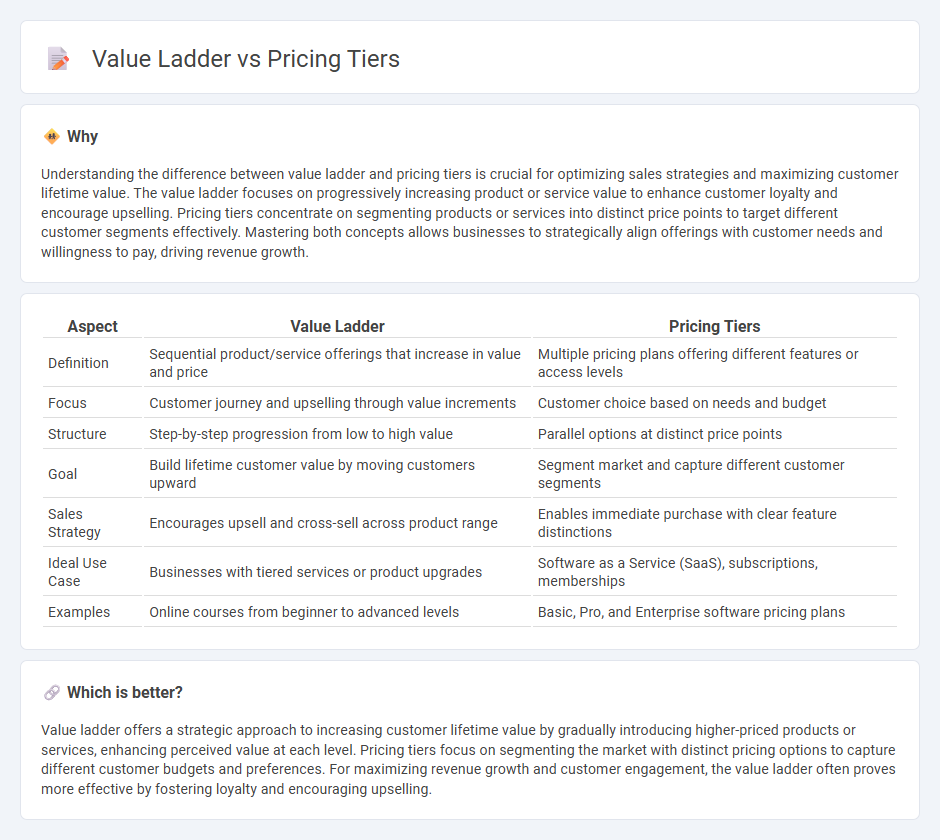
Sales strategies often include value ladders and pricing tiers, which help businesses segment offerings based on customer needs and budget levels. Value ladders focus on progressively increasing product or service value to encourage upselling, while pricing tiers present distinct packages at set price points to capture diverse market segments. Explore our detailed analysis to understand how these approaches can boost your revenue.
Why it is important
Understanding the difference between value ladder and pricing tiers is crucial for optimizing sales strategies and maximizing customer lifetime value. The value ladder focuses on progressively increasing product or service value to enhance customer loyalty and encourage upselling. Pricing tiers concentrate on segmenting products or services into distinct price points to target different customer segments effectively. Mastering both concepts allows businesses to strategically align offerings with customer needs and willingness to pay, driving revenue growth.
Comparison Table
| Aspect | Value Ladder | Pricing Tiers |
|---|---|---|
| Definition | Sequential product/service offerings that increase in value and price | Multiple pricing plans offering different features or access levels |
| Focus | Customer journey and upselling through value increments | Customer choice based on needs and budget |
| Structure | Step-by-step progression from low to high value | Parallel options at distinct price points |
| Goal | Build lifetime customer value by moving customers upward | Segment market and capture different customer segments |
| Sales Strategy | Encourages upsell and cross-sell across product range | Enables immediate purchase with clear feature distinctions |
| Ideal Use Case | Businesses with tiered services or product upgrades | Software as a Service (SaaS), subscriptions, memberships |
| Examples | Online courses from beginner to advanced levels | Basic, Pro, and Enterprise software pricing plans |
Which is better?
Value ladder offers a strategic approach to increasing customer lifetime value by gradually introducing higher-priced products or services, enhancing perceived value at each level. Pricing tiers focus on segmenting the market with distinct pricing options to capture different customer budgets and preferences. For maximizing revenue growth and customer engagement, the value ladder often proves more effective by fostering loyalty and encouraging upselling.
Connection
Value ladder and pricing tiers are interconnected by structuring product offerings to progressively enhance perceived value while increasing price points. Each step on the value ladder corresponds to distinct pricing tiers that reflect the added benefits and features customers receive. This strategic alignment encourages customer progression through higher tiers, maximizing revenue and customer lifetime value.
Key Terms
Segmentation
Pricing tiers segment customers by offering distinct packages based on features, usage, or budget, enabling targeted appeals to specific market segments. Value ladder emphasizes progressive offerings that increase customer lifetime value by guiding buyers through ascending levels of product or service value. Explore detailed strategies to effectively implement segmentation using both pricing tiers and the value ladder to maximize sales growth.
Perceived Value
Pricing tiers segment products or services into distinct levels based on features and benefits, enhancing customer choice and maximizing revenue through differentiated offerings. The value ladder emphasizes increasing perceived value at each step, encouraging customers to ascend by accessing progressively more comprehensive or premium solutions. Discover how aligning pricing tiers with a strategic value ladder can elevate customer perception and boost sales.
Upselling
Pricing tiers segment products or services into distinct levels based on features or benefits, facilitating targeted customer choices. The value ladder emphasizes incremental value delivery, encouraging customers to ascend through increasingly comprehensive offerings via upselling strategies. Explore how optimizing these frameworks enhances revenue by guiding buyers through tailored upsell opportunities.
Source and External Links
What is Tiered Pricing? Definition, Examples, Best Practices - Explains tiered pricing as offering multiple pricing levels (e.g., three-tier pricing: Personal, Professional, Business) to appeal to different customer segments, helping customers compare options and encouraging upgrades for revenue growth.
What is Tiered Pricing? Types and Strategies for 2025 - Shopify - Describes tiered pricing models including feature-based, subscription-based, usage-based, and dynamic, showing how varying features or quantities at different price points attract diverse customers and encourage higher-value purchases.
Mastering tiered pricing: Strategy for revenue maximization - Details tiered pricing as a flexible model offering different price points aligned with features or volume to maximize revenue and customer satisfaction across market segments.
 dowidth.com
dowidth.com